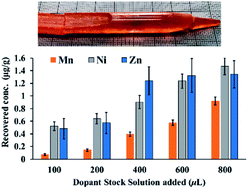Purity analysis for room-temperature semiconductor radiation detection material, CsPbBr3, using ICP-MS†
Abstract
An inductively coupled plasma mass spectrometry (ICP-MS) protocol was developed for trace impurity analysis of the halide perovskite semiconductor, CsPbBr3. Method validation was performed by doping solution synthesized CsPbBr3 samples with distinct amounts of a multi-element mixture. The limit of detection (LOD) for the twelve doped elements (Zn, Cr, Ga, Mn, Tl, Bi, As, In, Sn, Ni, Se and Sb) ranged from 0.0004 μg L−1 to 0.377 μg L−1, whereas the limit of quantification (LOQ) ranged from 0.001 μg L−1 to 1.26 μg L−1. Apart from Cr and Se, a linear relationship between doped and detected concentration was observed amongst these elements. The validated ICP-MS process was applied to a high temperature zone-refined CsPbBr3 ingot to study impurity segregation. The total impurity levels (TIL) of the zone-refined samples range from 15.7 ± 1.3 to 54.6 ± 1.2 μg g−1 and depend on the positions of the samples within the ingot.



 Please wait while we load your content...
Please wait while we load your content...